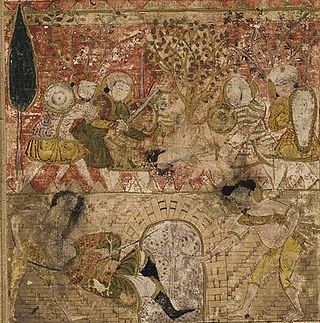Safiyya bint Huyayy was a Jewish woman from the Banu Nadir tribe. After the Battle of Khaybar in 628, she was widowed and taken captive by the early Muslims and subsequently became Muhammad's tenth wife. Like all other women who were married to Muhammad, Saffiya was known to Muslims as a Mother of the Believers. Their marriage produced no children and ended with Muhammad's death in Medina in 632.

Musaylima, otherwise known as Musaylima ibn Ḥabīb d.632, was a claimant of prophethood from the Banu Hanifa tribe, of which present day descendants include the House of Saud among other Najd tribes. Based from Diriyah in present day Riyadh, Saudi Arabia, he claimed to be a prophet and was an opponent of Islam in 7th-century Arabia. He was a leader during the Ridda wars. He is considered by Muslims to be a false prophet. He is commonly called Musaylima al-Kadhāb.
The Banu Nadir were a Jewish Arab tribe that lived in northern Arabia at the oasis of Medina until the 7th century. They were expelled by Muhammad after The Battle of Uhud against the Quraysh, which took place after attacks by the Muslims on their trade caravans and to revenge themselves for Badr.
Muhammad ibn Maslamah al-Ansari was a companion of the Islamic prophet Muhammad. He was known as "The Knight of Allah's Prophet". His kunya was Abu Abdullah or Abu Abdurrahman. Ibn Maslamah embraced Islam before the Hijrah of Muhammad and his followers. Ibn Maslamah witnessed all the battles except for the expedition of Tabuk, as he was appointed as deputy governor of Medina during the campaign.
The Expedition of Qatan, was the first Raid on the Banu Asad bin Khuzaymah tribe, which occurred directly after the Battle of Hamra al-Asad in the year 4 A.H of the Islamic calendar.
The early Muslim–Meccan conflict refer to a series of raids in which the Islamic prophet Muhammad and his companions participated. The raids were generally offensive and carried out to gather intelligence or seize the trade goods of caravans financed by the Mushrik of the Quraysh. His followers were also impoverished. The raids were intended to harm the economy and in turn the offensive capabilities of Mecca by Muhammad. The Muslims felt that the raids were justified in that the items being sold in the caravans were their own items, stolen by the Meccans when they had fled to Medina.
The raid on Amarr, also known as the Raid on Ghatafan, occurred directly after the Invasion of Sawiq in the year A.H. 3 of the Islamic calendar, March 624. The expedition was ordered by Muhammad after he received intelligence that the Banu Muharib and Banu Thalabah tribes were planning to raid the outskirts of Madinah. Therefore, Muhammad launched a pre-emptive strike with 450 men.
The Expedition of Bir Maona, according to Islamic tradition, took place four months after the Battle of Uhud in the year A.H. 4 of the Islamic calendar. It is believed the Islamic prophet Muhammad sent missionaries to preach Islam, at the request of Abu Bara. Forty or seventy of the Muslim missionaries sent by Muhammad were killed.
The invasion of Banu Nadir took place in May 625 CE 4. The account is related in Surah Al-Hashr which describes the banishment of the Jewish tribe Banu Nadir who were expelled from Medina after plotting to assassinate the Islamic prophet Muhammad.

The siege of Banu Qurayza took place in Dhul Qa‘dah during January of 627 CE and followed on from the Battle of the Trench.
The Second raid on Banu Thalabah took place in August, 627AD in 4th month of, 6AH of the Islamic calendar, under the leadership of Abu Ubaidah
The Expedition of Dhu Qarad also known as the Expedition of Ghaba took place in September, 627AD, 6AH of the Islamic calendar, some scholars say that it took place just before the Battle of Khaybar, in the 12th month of 6AH.
Third Raid on Banu Thalabah took place in September, 627AD, 6th month of 6AH of the Islamic calendar
The Expedition of al-Muraysiʿ was an early Muslim campaign against the tribe of Banu Mustaliq which took place in December 627 CE.
The Expedition of Uyainah bin Hisn, against the Banu Tamim tribe took place in July 630, 9AH, 1st month, of the Islamic Calendar.
The demolition or burning of Masjid al-Dirar , or the Mosque of Dissent, is mentioned in the Qur'an. Masjid al-Dirar was a Medinian mosque that was erected close to the Quba Mosque and which the Islamic prophet Muhammad initially approved of but subsequently had destroyed while he was returning from the Expedition to Tabouk. In the main account narrated by the majority of scholars, the mosque was built by 12 hypocrites (munafiqeen) on the commands of Abu 'Amir al-Rahib; a Hanif who refused Muhammad's invitation to Islam and instead fought along with the Meccan non-Muslims against Islam in the Battle of Uhud. Abu 'Amir reportedly urged his men to establish a stronghold and prepare whatever they can of power and weapons as he promised and insinuated to them that he will lead an army, backed by Heraclius, to fight Muhammad and his companions, and defeat his message by expelling him from Medina. Ahmad ibn Yahya al-Baladhuri also relates that the men, who built the Al-Dirar mosque "for mischief and for infidelity and to disunite the Believers" refused to pray in Quba Mosque claiming that it was built in a place where a donkey used to be tied up.
Banu Tha'labah was a tribe during the Islamic prophet Muhammad's era. They were involved in many military conflicts with Muhammad.

Raid on al-Ghabah was a military expedition of the Islamic Prophet Muhammad that took place in 6AH of the Islamic calendar. No orders given by Muhammad in this expedition but Amr ibn al-Akwa attacks Uyanah bin Hisn Al-Fazari after seeing him seize 20 of Muhammad's camels. One Muslim shepherd was killed, and his wife captured.
Abu al-Hudhayl Zufar ibn al-Harith al-Kilabi was a Muslim commander, a chieftain of the Arab tribe of Banu Amir, and the preeminent leader of the Qays tribal–political faction in the late 7th century. During the First Muslim Civil War he commanded his tribe in A'isha's army against Caliph Ali's forces at the Battle of the Camel near Basra in 656. The following year, he relocated from Iraq to the Jazira and fought under Mu'awiya ibn Abi Sufyan, future founder of the Umayyad Caliphate, against Ali at the Battle of Siffin. During the Second Muslim Civil War he served Mu'awiya's son, Caliph Yazid I, leading the troops of Jund Qinnasrin against anti-Umayyad rebels in the 683 Battle of al-Harra.
Ghalib ibn Abd Allah al-Laythi also known as Ghalib ibn Fadala al-Laythi, was an early companion and commander of the Islamic prophet Muhammad. During the prophet's lifetime, he led several expeditions against the polytheistic Bedouin tribes. He later participated in the conquest of Iraq in 634–636 and briefly as a commander in Khurasan in 668–671.